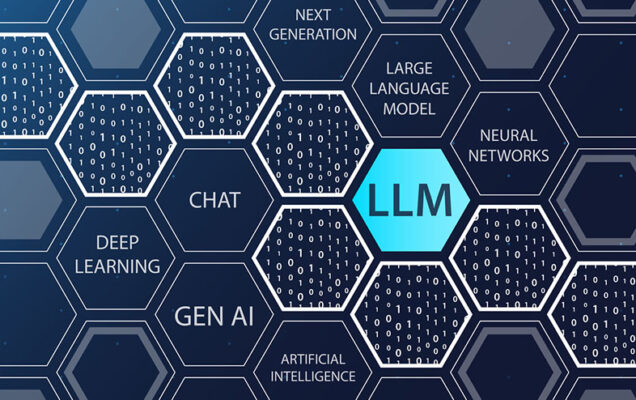
In the rapidly evolving realm of technology, industries are perpetually on the lookout for avenues to streamline operations, cut costs, and enhance efficiency. A pivotal innovation that has gained prominence in recent years is Robotic Process Automation (RPA), marking a significant stride for enterprises seeking to automate repetitive tasks and amplify productivity. However, envision elevating RPA to unprecedented heights by integrating Large Language Models (LLMs) into its framework. This blog delves into the concept of LLM-powered Robotic Process Automation and its potential to revolutionize global industries.
The Ascendance of Robotic Process Automation (RPA)
Robotic Process Automation stands as a technological breakthrough empowering businesses to automate rule-based tasks using software bots or “robots.” These bots are adeptly programmed to execute tasks with swiftness and precision, akin to human performance but with heightened accuracy. RPA has carved out its niche across diverse sectors such as finance, healthcare, customer service, and manufacturing, effectively curbing human errors, amplifying operational efficiency, and liberating human resources for strategic initiatives.
Decoding Large Language Models (LLMs)
Large Language Models constitute a breed of artificial intelligence models engineered to comprehend and generate human language proficiently. Leveraging sophisticated deep learning techniques, particularly transformer neural network architectures, LLMs excel in a spectrum of natural language processing tasks. They find applications in natural language understanding, machine translation, chatbot development, content generation, and beyond, underscoring ongoing advancements aimed at fortifying their capabilities and surmounting inherent challenges.
Key Attributes of Large Language Models:
- Expansive Capacity: LLMs, exemplified by models like GPT-3 and GPT-4, boast vast parameter counts in the billions. This scale empowers them to absorb and synthesize extensive linguistic data, enabling nuanced comprehension and generation of human-like text across diverse subjects and languages.
- Training Dynamics: Initially pre-trained on massive internet-based text corpora, LLMs acquire proficiency in grammar, vocabulary, and broad-ranging knowledge domains. Fine-tuning further customizes these models for specific tasks or sectors, augmenting their applicability and performance.
- Generative Prowess: LLMs demonstrate the capability to produce coherent, contextually relevant text, facilitating tasks such as text synthesis, language translation, summarization, and more.
- Natural Language Proficiency: Excelling in natural language understanding tasks, including sentiment analysis, text categorization, and question answering, LLMs adeptly decipher and interpret text within contextual frameworks, delivering insightful responses.
- Adaptability: Characterized by versatility, LLMs can swiftly adapt to various language-oriented tasks with minimal task-specific training, ensuring agile deployment across diverse operational domains.
- Ethical Considerations: The evolution and deployment of LLMs necessitate conscientious consideration of ethical implications, encompassing concerns about misinformation propagation, bias mitigation, and privacy safeguards.
- Computational Requirements: Harnessing LLM capabilities mandates substantial computational resources, encompassing robust hardware infrastructure and access to extensive datasets, thereby primarily accessible to well-resourced enterprises and research entities.
The Influence of Large Language Models (LLMs)
Large Language Models, exemplified by advanced iterations like GPT-3.5, have captivated attention for their adeptness in processing and generating human-like textual content. Pre-trained on colossal textual datasets, these models transcend conventional language processing boundaries, undertaking tasks encompassing language translation, content creation, and precise question answering, showcasing transformative potential across natural language processing and artificial intelligence disciplines.
The Synergy of LLMs and RPA
Picture a scenario where RPA bots not only execute predefined tasks but also possess the ability to comprehend and generate human language. This integration marks a paradigm shift, epitomizing the synergy between LLMs and RPA. Here’s how LLM-powered RPA promises to redefine industries:
- Enhanced Customer Engagement: LLM-powered RPA bots engage in fluid, human-like dialogues with customers, adeptly addressing queries, delivering personalized responses, and resolving complex issues via extensive knowledge repository access. This automation enhances customer service efficacy, slashing response times while ensuring consistently high service standards.
- Intelligent Data Handling: In sectors such as finance and healthcare, proficient data analysis stands pivotal. LLM-powered RPA bots not only parse data comprehensively but also generate actionable reports intelligible to human comprehension. This capability optimizes resource allocation, expediting data-driven decision-making processes.
- Streamlined Document Management: Organizations grappling with voluminous document processing requirements benefit from LLM-powered RPA bots adeptly extracting, categorizing, and synthesizing document content. This streamlines workflow efficiencies, curtails manual error margins, and accelerates document throughput.
- Multilingual Proficiency: Global enterprises grappling with linguistic barriers find solace in LLM-powered RPA bots proficiently translating between languages, facilitating seamless communication across diverse geographies and stakeholders.
- Continuous Adaptation: LLMs’ intrinsic capacity for adaptive learning empowers LLM-powered RPA bots to continually refine performance metrics. These bots remain attuned to evolving industry dynamics, regulatory stipulations, and shifting consumer preferences, ensuring sustained service excellence.
Challenges and Considerations
Despite its transformative promise, integrating LLMs into RPA introduces nuances warranting deliberation:
- Data Security: Safeguarding sensitive data necessitates robust encryption protocols and stringent data protection measures.
- Ethical Imperatives: Mitigating the risks of misinformation propagation and bias demands conscientious oversight and ethical governance frameworks.
- Integration Complexity: Harmonizing LLM capabilities with existing RPA infrastructures mandates meticulous planning, specialized expertise, and resource allocation.
Charting the Future of LLM-Powered RPA
The evolution of LLM-powered Robotic Process Automation portends a watershed moment in automation’s evolution. By infusing tasks with sophisticated language understanding and generation capabilities, enterprises stand poised to unlock unprecedented operational efficiencies and competitive advantages. Embracing LLM-powered RPA positions organizations on the vanguard of technological innovation, reshaping operational paradigms, customer interactions, and data analytics landscapes.
In summation, LLM-powered Robotic Process Automation represents a transformative leap forward, promising to redefine business operations, customer engagements, and data analytics methodologies. While confronting inherent challenges, the potential dividends of this integration remain unequivocally compelling. As the automation frontier evolves, the intersection of LLMs with RPA heralds a future where intelligent automation emerges as a cornerstone of enterprise competitiveness and operational excellence.